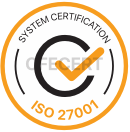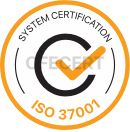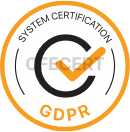The digital backbone of the financial sector is so critical that even minor disruptions can lead to major breakdowns. The European Union’s Digital Operational Resilience Act (DORA) imposes comprehensive responsibilities on financial institutions to manage this fragility. It mandates the establishment of resilient structures across multiple areas—from operational risk and data security to service continuity and third-party management. Ensuring these structures are sustainable and applicable requires alignment with international standards. Standards such as ISO 27001, 22301, 27035, 31000, and 22316 directly correspond to DORA’s technical and managerial requirements.
This content will address which management system standards should be integrated to meet key requirements under DORA.
1. ISO/IEC 27001 – Information Security Management System (ISMS)
This standard ensures the identification, implementation, and continuous monitoring of risk-based controls to protect the confidentiality, integrity, and availability of information assets. It includes formalizing security policies, enforcing access controls, defining incident reporting procedures, and conducting regular internal audits. Automated monitoring systems can integrate with threat intelligence sources, enabling early detection of potential attacks. ISO 27001 details the processes for technically monitoring, reporting, and controlling information security breaches.
This framework aligns directly with DORA’s requirements for 24-hour incident reporting and continuous monitoring.
2. ISO 22301 – Business Continuity Management System (BCMS)
This standard ensures preparedness for disruptive events, the creation of response plans, and guarantees service continuity. Business Impact Analysis (BIA), disaster scenarios, recovery time objectives (RTO/RPO), and regular drills are fundamental elements. The institution targets sustainability against both physical and digital disruptions in operational services.
DORA’s requirement for continuous access to digital services and having defined and tested recovery plans is fully addressed by ISO 22301.
3. ISO 20000-1 – IT Service Management System
ISO 20000-1 ensures that IT services are delivered through planned, traceable, and repeatable processes, minimizing risks like system outages and data loss. Financial institutions are under the scrutiny of regulators such as BDDK, MASAK, KVKK, and SPK. ISO 20000-1 supports compliance through well-defined processes, particularly in service level, change, and incident management. As the finance sector embraces digital transformation—including mobile banking, AI-powered customer service, and API-based open banking—this standard can serve as a foundational “infrastructure backbone.”
4. ISO 27701 – Privacy Information Management System
The financial sector processes large volumes of personal data (e.g., ID numbers, financial history, credit scores, spending habits). ISO 27701 helps answer critical questions such as how data is processed, with whom it is shared, and how long it is retained. This strengthens compliance with regulations like GDPR and KVKK.
5. NIST Cybersecurity Framework
The NIST Cybersecurity Framework helps institutions identify, manage, and reduce cyber risks. Although developed outside the EU, it aligns closely with DORA requirements. It comprises five core functions: Identify, Protect, Detect, Respond, Recover.
NIST’s “Identify” and “Protect” functions provide a strong foundation for risk inventories, impact analyses, and control strategies. It complements frameworks like ISO 27001, PCI-DSS, and FFIEC. The “Respond” and “Recover” functions are especially critical for IT service continuity and crisis management—essential in the high-cost environment of financial service disruptions. NIST also offers guidance for evaluating third-party provider security, a crucial aspect of DORA.
6. COBIT – IT Governance and Management Framework
Developed by ISACA, COBIT is a governance and management framework that ensures the effective and controlled use of IT resources in line with business objectives.
COBIT 2019 offers detailed guidance through five governance principles and nearly 40 Governance & Management Objectives, split into:
- Governance Objectives (GOV): Corporate IT governance
- Management Objectives (MAN): IT operations and management
DORA demands resilience not only technically but also at the governance level. COBIT addresses this by defining responsibilities, decision-making processes, and governance structures. Its performance measurement and continuous improvement framework supports DORA’s expectation of “measurable operational resilience.” COBIT’s RACI-based model also helps clearly assign roles, which is critical for compliance with DORA.
7. ISO/IEC 27035 – Information Security Incident Management
This standard defines the technical and managerial processes for managing the lifecycle of information security incidents. It covers incident identification, classification, response workflows, and systematic improvement steps. It supports creating cyber incident notification chains aligned with both internal and external regulatory requirements.
DORA’s requirements for incident notification, classification, and cyclical implementation of corrective actions are comprehensively addressed in ISO/IEC 27035.
8. ISO 31000 – Risk Management
This standard enables systematic identification, assessment, and monitoring of risks at all organizational levels. It supports response plans aligned with the institution’s risk appetite, with continuous monitoring and review processes. It holistically addresses strategic, operational, and technological risks.
ISO 31000 provides a foundational structure for managing operational risks and audit processes related to digital infrastructures under DORA.
9. ISO 22316 – Organizational Resilience
This standard enhances an organization’s strategic and cultural resilience to internal and external changes. It evaluates elements like resource utilization, leadership, internal communication, organizational learning, and agility. It prepares the institution beyond technological infrastructure, adopting a holistic approach.
The core of DORA’s digital resilience vision is the ability to adapt to an ever-changing threat landscape—something ISO 22316 is designed to support.
In a world where financial and technological infrastructures grow increasingly complex, uninterrupted and secure operations have become essential. International standards such as ISO/IEC 27001, ISO/IEC 27035, ISO 22301, ISO 31000, and ISO 22316 enable structured management of digital operations. When implemented together, these standards transform your organization into a system that protects information assets, ensures preparedness, and supports sustainable resilience against operational disruptions.
For DORA compliance, these five standards help rebuild your institution’s technical requirements and corporate culture around digital risk management.
For training, gap analysis, and tailored management system solutions for your organization, you can reach us at sales@cfecert.co.uk.








